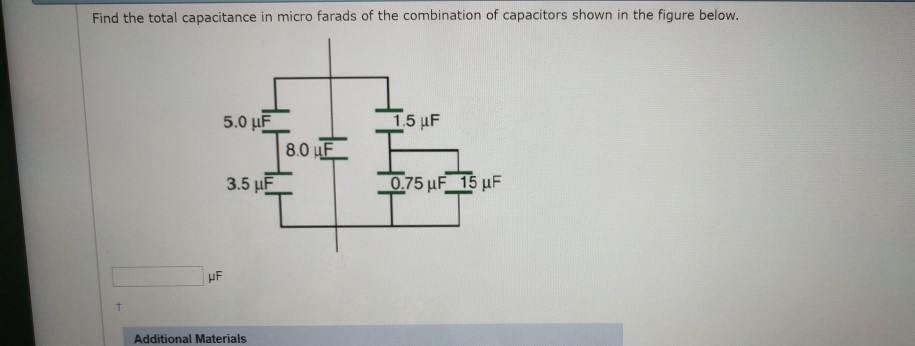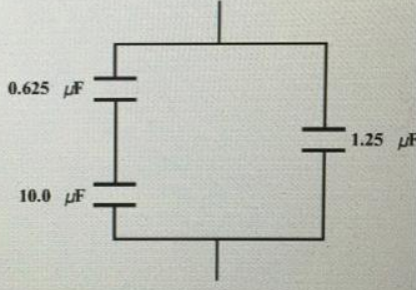How To Find The Total Capacitance Of The Combination Of Capacitors - 10 uf 2.5 uf 0.30 uf figure 19.32 a combination of series and parallel connections of capacitors.
How To Find The Total Capacitance Of The Combination Of Capacitors - 10 uf 2.5 uf 0.30 uf figure 19.32 a combination of series and parallel connections of capacitors.. As for any capacitor, the capacitance of the combination is related to charge and voltage by c=qvc=qv. To find the equivalent total capacitance cp, we first note that the voltage across each capacitor is v, the same as that of the source, since they are connected directly to it through a conductor. The total charge q is the sum of the individual charges: q = q1 + q2 + q3. Round your answer to three decimal places. Using the relationship q = cv, we see that the total charge is q = cpv, and the individual charges are q1 = c1v, q2 = c2v, and q3 = c3v.
V = v 1 + v 2. Assume the capacitances in figure 19.22 are known to three decimal places ( c 1 = 1.000 µf c 1 = 1.000 µf , c 2 = 5.000 µf c 2 = 5.000 µf , and c 3 = 8.000 µf c 3 = 8.000 µf ), and round your answer to three decimal places. We can find an expression for the total capacitance by considering the voltage across the individual capa. We have more than 30 years experience trading difficult to find electronic parts Chapter 19, problem 60pe is solved.
Round your answer to three decimal places.
Nov 05, 2020 · find the total capacitance of the combination of capacitors shown in figure 8.3. This problem has been solved: The total potential difference across combination is: As for any capacitor, the capacitance of the combination is related to charge and voltage by c=qvc=qv. (see figure 1b.) larger plate separation means smaller capacitance. The potential difference across c 1 and c 2 is different i.e., v 1 and v 2. And then, take the reciprocal of that sum, and we end up with 0.29 microfarads with the equivalent capacitance in total. .antananaritor bank with a total Find the total capacitance of the combination of capacitors shown in figure 19.34. So we have one over 12.5 microfarads plus one over 0.30 microfarads. Note in figure 1 that opposite charges of magnitude q flow to either side of the originally uncharged combination of capacitors when the voltage vis applied. We can find an expression for the total capacitance by considering the voltage across the individual capa. So we take the reciprocal of capacitor 1 and so that's 1 over c 1 and add that to the reciprocal of capacitance two, find that sum then take the reciprocal of that sum and that will be our equivalent capacitance.
So we take the reciprocal of capacitor 1 and so that's 1 over c 1 and add that to the reciprocal of capacitance two, find that sum then take the reciprocal of that sum and that will be our equivalent capacitance. And so, this exponent negative one means take the reciprocal of the result in here. The total potential difference across combination is: The end result is that the combination resembles a single capacitor with an effective plate separation greater than that of the individual capacitors alone. Assume the capacitances are known to three decimal places (c 1 = 1.000 μ f, c 2 = 5.000 μ f, c 3 = 8.000 μ f).

As for any capacitor, the capacitance of the combination is related to charge and voltage by c=qvc=qv.
Find the total capacitance of the combination of capacitors in figure 19.33. This problem has been solved: We can find an expression for the total capacitance by considering the voltage across the individual capa. 10 uf 2.5 uf 0.30 uf figure 19.32 a combination of series and parallel connections of capacitors. Ebay is here for you with money back guarantee and easy return. Canceling vfrom the equation, we obtain the equation for the total capacitance in parallel cp: cp = c1 + c2 + c3+ …. 98% (65 ratings) for this solution. Here the total capacitance is easier to find than in the series case. V = q c 1 + q c 2 v=\frac{q}{{{c}_{1}}}+\frac{q}{{{c}_{2}}} v = c 1 q + c 2 q Note in figure 1 that opposite charges of magnitude q flow to either side of the originally uncharged combination of capacitors when the voltage vis applied. (see figure 1b.) larger plate separation means smaller capacitance. Figure 1a shows a series connection of three capacitors with a voltage applied. Q = c 1 v 1 = c 2 v 2.
See full list on courses.lumenlearning.com When capacitors are connected in series, the magnitude of charge q on each capacitor is same. So we have one over 12.5 microfarads plus one over 0.30 microfarads. Here the total capacitance is easier to find than in the series case. Ebay is here for you with money back guarantee and easy return.

We can find an expression for the total capacitance by considering the voltage across the individual capa.
V = v 1 + v 2. Entering these into the previous equation gives cpv = c1v + c2v + c3v. Canceling vfrom the equation, we obtain the equation for the total capacitance in parallel cp: cp = c1 + c2 + c3+ …. Find the total capacitance of the combination of capacitors in figure 19.32. And then, take the reciprocal of that sum, and we end up with 0.29 microfarads with the equivalent capacitance in total. (conductors are equipotentials, and so the voltage across the capacitors is the same as that across the voltage source.) thus the capacitors have the same charges on them as they would have if connected individually to the voltage source. The net capacitance of an arrangement consisted of capacitor in series and parallel configuration. How to calculate capacitance in series and parallel? Using the relationship q = cv, we see that the total charge is q = cpv, and the individual charges are q1 = c1v, q2 = c2v, and q3 = c3v. To find the equivalent total capacitance cp, we first note that the voltage across each capacitor is v, the same as that of the source, since they are connected directly to it through a conductor. How to describe a series combination of capacitors? It is a general feature of series connections of capacitors that the total capacitance is less than any of the individual capacitances. Assume the capacitances are known to three decimal places (c 1 = 1.000 μ f, c 2 = 5.000 μ f, c 3 = 8.000 μ f).
antananaritor bank with a total how to find total capacitance. .antananaritor bank with a total